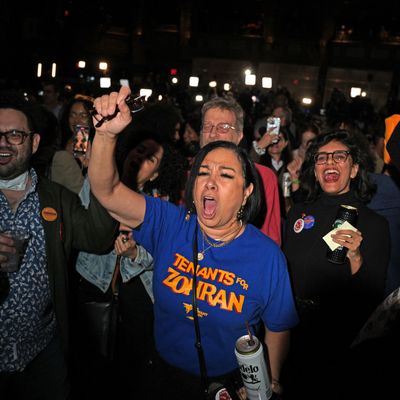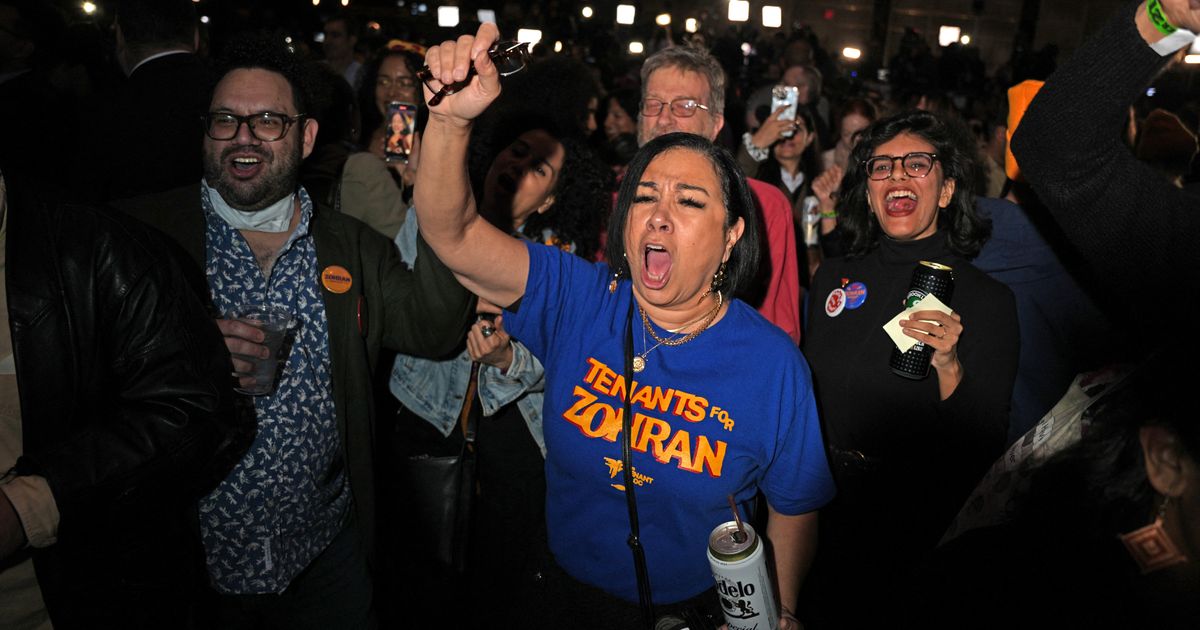
Supporters of Zohran Mamdani celebrate during an election night event at the Brooklyn Paramount Theater on Tuesday.
Photo: Angelina Katsanis/AFP/Getty Images
When New Yorkers elected Zohran Mamdani, they gave a much-needed boost to the next mayor by approving ballot measures that will ease the process of building housing, which experts say will be a boon to the mayor-elect’s ability to deliver on his campaign pledge to make the city more affordable.
Ballot questions Nos. 2 and 3 create a fast-track review process for publicly financed affordable-housing projects and cut down the time to review smaller projects. The fourth measure creates a board that has the power to overrule the City Council’s rejection of or revisions to affordable-housing proposals. Most significantly, the measures curtail the City Council’s input on land-use decisions, removing them from the review process and ending the practice of member deference, which gave councilmembers significant power to block projects in their communities.
“I think it’s going to shave a lot of time, possibly years, off some of the new affordable-housing units that the city is financing, so I think that’s really significant to the next mayor’s housing plan,” says Rachel Fee, the executive director of the New York Housing Conference.
Mamdani has promised to jump-start housing construction, with the goal of creating 200,000 units over the next ten years. Amit Singh Bagga, campaign director of the Yes on Affordable Housing PAC, which supported the ballot questions, said that such lofty goals will not be possible without these changes to the city’s housing process.
“Unless we are able to turbocharge the amount of housing that is produced every single year, we are not going to be able to meet that 200,000 figure that Zohran Mandani has promised for his first term. Because 15,000 to 20,000 units a year does not equal 200,000 in four years,” he says, referring to the current rate of housing creation in the city.
The measures would allow potential projects to avoid the typically lengthy Uniform Land Use Review Procedure that requires applications to undergo months of scrutiny by city agencies, as well as by the local community board and the borough president, culminating in a City Council vote that is subject to the mayor’s approval or veto.
The City Council swiftly condemned the proposed measures and moved to defeat them, first attempting to block the questions from appearing on the ballot and later launching a campaign that spent more than $1.5 million on mailers urging voters to reject the allegedly “misleading” ballot questions — actions that some critics believe run afoul of the city’s laws against electioneering.
Bagga believes the reaction to the measures has been overblown and that the City Council was removed from these review processes for a good reason. “The reason for that is that our current system has essentially been weaponized by a small-minded few that have forced individual City Council members into a Hobson’s choice, which is block housing or lose your seat. What that has resulted in is a total lack of movement on housing for decades in multiple iterations of the Council,” he says. However, he did offer praise for the current City Council and its Speaker, Adrienne Adams, noting that they ushered through the “City of Yes” plan to build more housing.
Mamdani was notably mum on his position on the ballot measures throughout the election. Some of his most prominent allies were on opposite sides of the issue, with Comptroller Brad Lander, Governor Kathy Hochul, and Cea Weaver, who has advised Mamdani on housing policy, supporting the measures and union backers like Local 32BJ SEIU and the Hotel and Gaming Trades Council opposing them. Ultimately, Mamdani revealed Tuesday that he voted “yes” on the proposals.
Fee believes that the measures could spur new construction in areas long seen as resistant to new housing and will motivate developers to give project proposals a second look. “If those proposals require a councilmember saying ‘yes’ in the City Council and that councilmember has indicated to the development community that their answer is going to be ‘no,’ nobody’s even looking at sites. Nobody is looking at those opportunities. They’re not going to take the risk of buying a site, investing time and money in a ULURP process that’s going to go nowhere,” she says.
“I do think developers will take a fresh look at some of these areas where we’ve not been building any housing at all and that we will see some new proposals come up that never would have without these changes,” she says.

